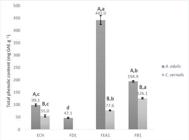ABSTRACT
Allophylus edulis and Cupania vernalis (Sapindaceae) are Brazilian native trees used as medicinal plants for the treatment of respiratory, digestive, circulatory, and skin diseases. Ubiquitously distributed in the Brazilian territory, these species are indicated for mixed plantations aimed at the recovery of degraded ecosystems. In this study, the total phenolic content (TPC) and total flavonoid content (TFC), and the antioxidant activity of extracts and fractions obtained from A. edulis and C. vernalis leaves were assessed. The TPC and TFC was determined spectrophotometrically. Antioxidant activity was evaluated through radical scavenging activity of 2,2-diphenyl-1-picrylhydrazyl (DPPH). The extracts were obtained by two methods: maceration (method 1) and Soxhlet (method 2). Solvents of increasing polarity (hexane, dichloromethane, ethyl acetate, and n-butanol) were used to obtained the fractions. The results showed that the ethyl acetate fraction from A. edulis, obtained from the maceration method, had the highest TPC (442.0 ± 18.2 mg GAE g-1) and TFC (58.1 ± 0.4 mg RUE g-1), and antioxidant activity (EC50 = 43.6 ± 2.6 µg mL-1). By C. vernalis, superior results were obtained with the n-butanol fraction (TPC = 126.1 ± 5.8 mg GAE g-1, TFC = 37.7 ± 0.6 mg RUE g-1). The highest antioxidant potential was found in the crude hydroalcoholic extract (EC50 = 816.1 ± 50.9 µg mL-1) and butanol fraction (1,156.4 ± 3.8 µg mL-1). The results of this study show that the fractions obtained by maceration and liquid-liquid partition with more polar solvents (ethyl acetate and n-butanol) are the richest in TPC and TFC, and presented the greater antioxidant activity. Comparing the two plants, A. edulis showed the best results, with a high content of TPC, TFC, and antioxidant potential, and therefore may be used to treat diseases related to oxidative stress.
Keywords:
Free radical scavengers; Medicinal plants; Phytochemistry

 Thumbnail
Thumbnail
 Thumbnail
Thumbnail
 Thumbnail
Thumbnail


